Get ready to embark on a flavorful adventure through the Philippines! This guide dives into the vibrant world of Filipino Street Food, showcasing 21 popular snacks you’ll encounter across Manila and beyond. Prepare to tantalize your taste buds with these must-try treats!
Note: While this list focuses on Filipino street food snacks, stay tuned for a future article exploring the hearty main dishes of the Philippines.
(Optional: Embed Video Here – if possible within markdown constraints)
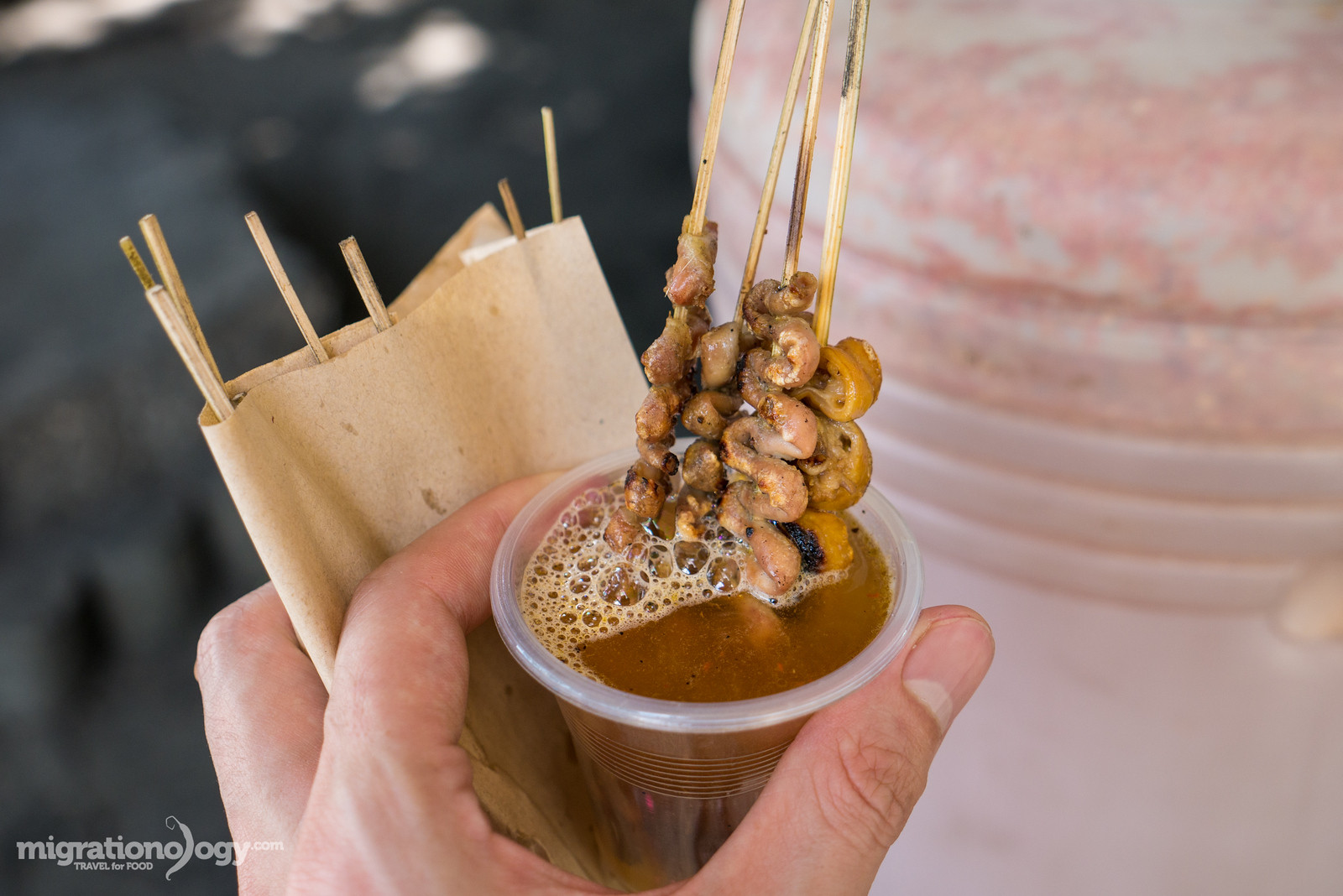 Grilled chicken intestines known as Isaw, a popular Filipino street food.
Grilled chicken intestines known as Isaw, a popular Filipino street food.
1. Isaw: The Reigning Champion of Filipino Street Food Grills
Isaw is arguably the king of Filipino street food snacks. As afternoon approaches in the Philippines, the enticing aroma of charcoal fills the air, signaling snack time. Isaw, available in both pig (isaw ng baboy) and chicken (isaw ng manok) intestines, are meticulously cleaned, coiled onto skewers, and grilled to smoky perfection.
Pig intestines offer a chewier texture and a more robust flavor, while chicken intestines are milder, resembling miniature grilled sausages. The magic of isaw, like many Filipino street foods, lies in the dipping sauce: vinegar. Locals often generously dunk their isaw skewers in a chili-onion vinegar, allowing the smoky flavors to meld with the tangy vinegar. This contrast is incredibly satisfying and a true Filipino street food experience.
Price: Approximately 5 PHP ($0.10) per skewer
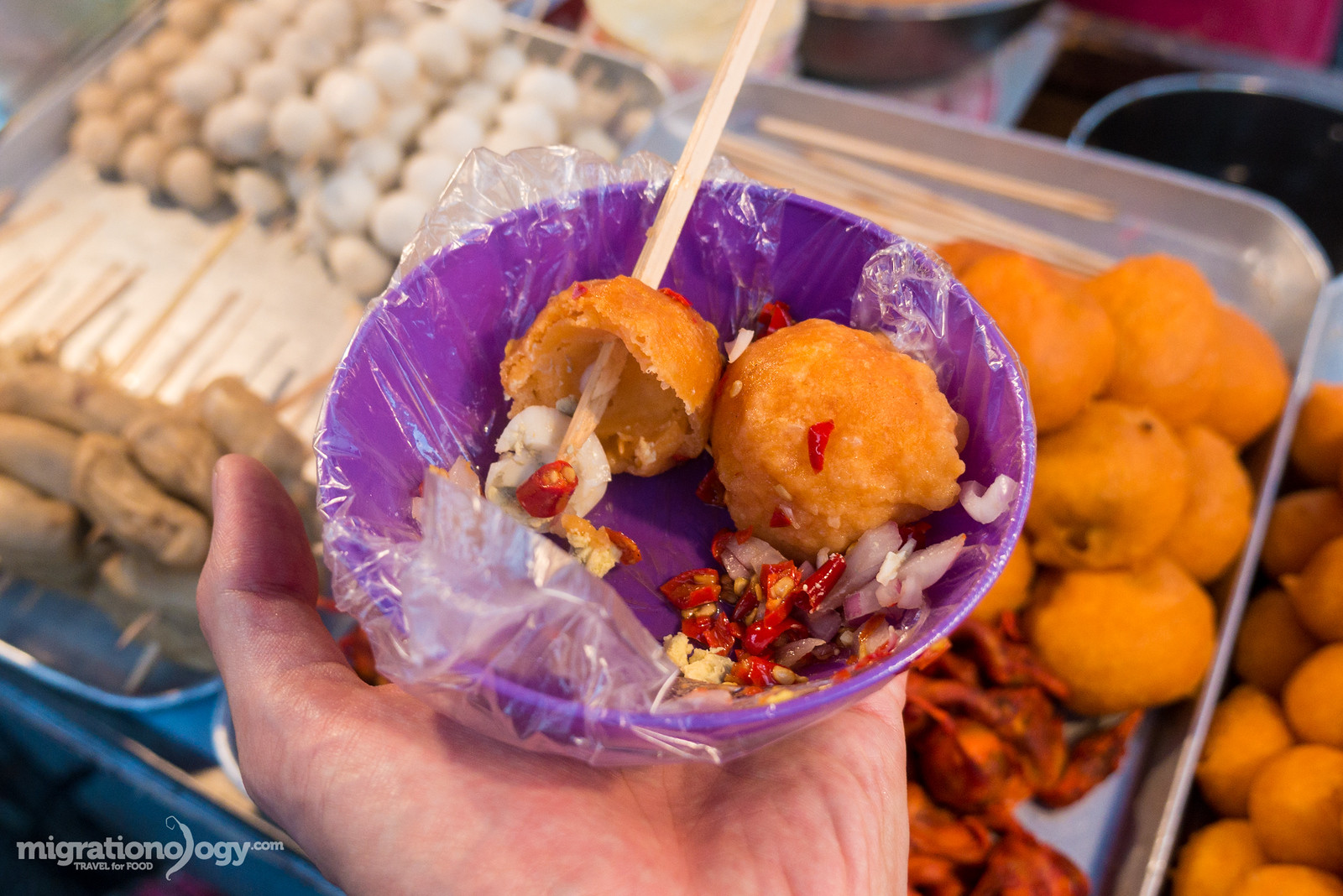 Deep-fried quail eggs in orange batter known as Kwek Kwek, a popular Filipino street food.
Deep-fried quail eggs in orange batter known as Kwek Kwek, a popular Filipino street food.
2. Kwek Kwek: Crispy Quail Egg Street Food Delight
Kwek kwek is another street food icon, beloved throughout Manila and the Philippines. These vibrant orange snacks are quail eggs coated in a distinctive orange-hued batter and deep-fried to a crispy, slightly chewy perfection. Their bright color and almost ping-pong ball-like appearance make them easily recognizable on the streets.
Like isaw, kwek kwek is best enjoyed with a vinegar dip, often enhanced with chilies and onions. This adds a crucial layer of acidity and spice that cuts through the richness of the fried batter. Think of kwek kwek as a Filipino twist on a corn dog, substituting a quail egg for the hot dog.
Price: 3 for 12 PHP ($0.24)
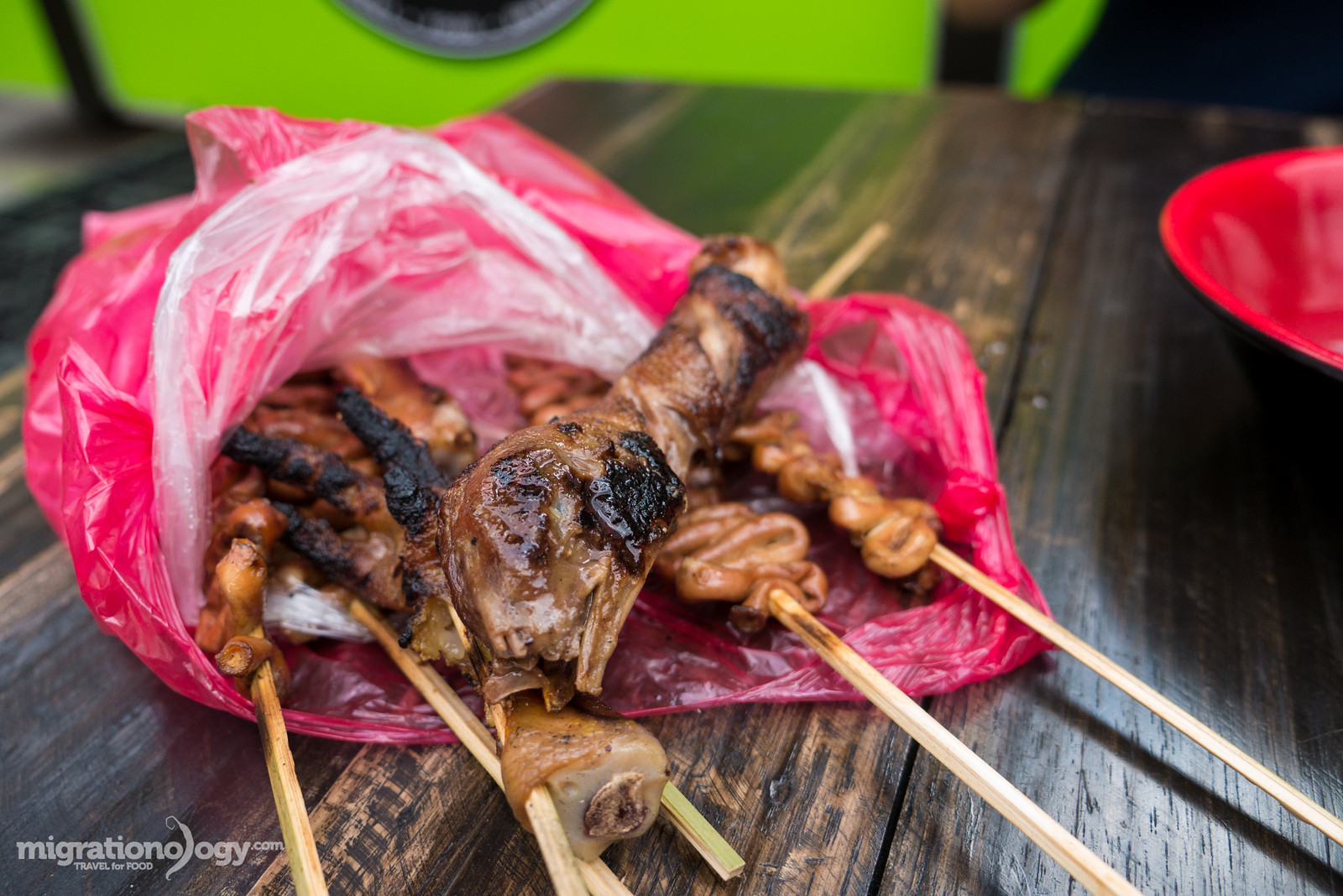 Grilled chicken heads and feet, known as Helmets and Adidas, common Filipino street foods.
Grilled chicken heads and feet, known as Helmets and Adidas, common Filipino street foods.
3. Helmets and Adidas: For the Adventurous Foodie
Filipino street food isn’t afraid to be adventurous, and “helmets” and “Adidas” are perfect examples. These playful names refer to chicken heads (helmets) and chicken feet (Adidas), respectively. Prepared similarly to isaw, they are skewered and grilled over charcoal, offering a unique culinary experience.
Chicken feet, while popular in many Asian cuisines, can be challenging for some due to the minimal meat. However, chicken heads, especially when including the neck, can be surprisingly flavorful. The grilling process imparts a smoky char, making them a tasty, albeit unconventional, snack for adventurous eaters.
Price: 5 PHP ($0.10) per skewer
Mango with Shrimp Paste – A delightful combination of sour mango and savory shrimp paste, a Filipino street food gem.
4. Mango with Shrimp Paste: A Flavor Explosion
Imagine a Filipino version of a caramel apple, but instead of a sweet apple, it’s a tart green mango, and instead of caramel, it’s a pungent, spicy shrimp paste (bagoong). This seemingly unusual combination is, for many, a top-tier Filipino street food experience.
Vendors typically use Indian mangoes (locally known as such), known for their firm, sour flesh. The mangoes are sliced off the seed, skewered, and generously slathered with shrimp paste upon ordering. The result is a flavor explosion: the crisp, intensely sour mango perfectly balanced by the salty, fishy, and slightly spicy shrimp paste. It’s a textural and taste sensation that’s both refreshing and addictive.
Price: 7 PHP ($0.14) per piece
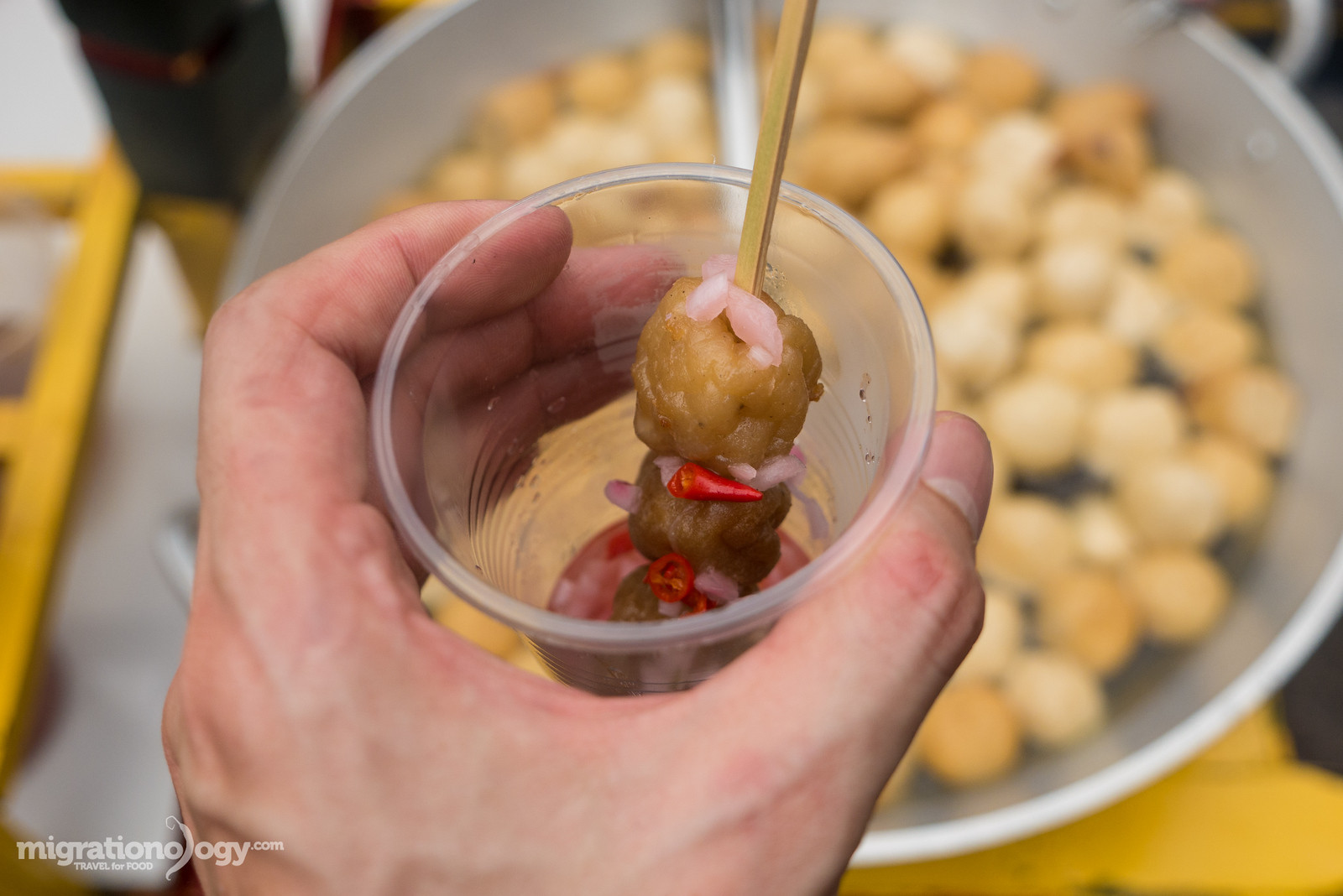 Fried fish balls and chicken balls, popular and affordable Filipino street food snacks.
Fried fish balls and chicken balls, popular and affordable Filipino street food snacks.
5. Fish Balls and Chicken Balls: A Southeast Asian Street Food Staple
Fried fish balls and chicken balls are incredibly popular Filipino street food snacks, especially among children. Their appeal extends throughout Southeast Asia, making them a familiar sight and taste in the region.
Street-style fish and chicken balls are often made with a higher proportion of flour than meat, making them affordable and accessible. They are deep-fried until golden brown and readily available from street vendors. The Filipino way to enjoy them is to skewer them directly from the hot oil, dip them into a chili-onion-vinegar sauce, and savor the simple yet satisfying flavors.
Price: 2 PHP ($0.04) per ball
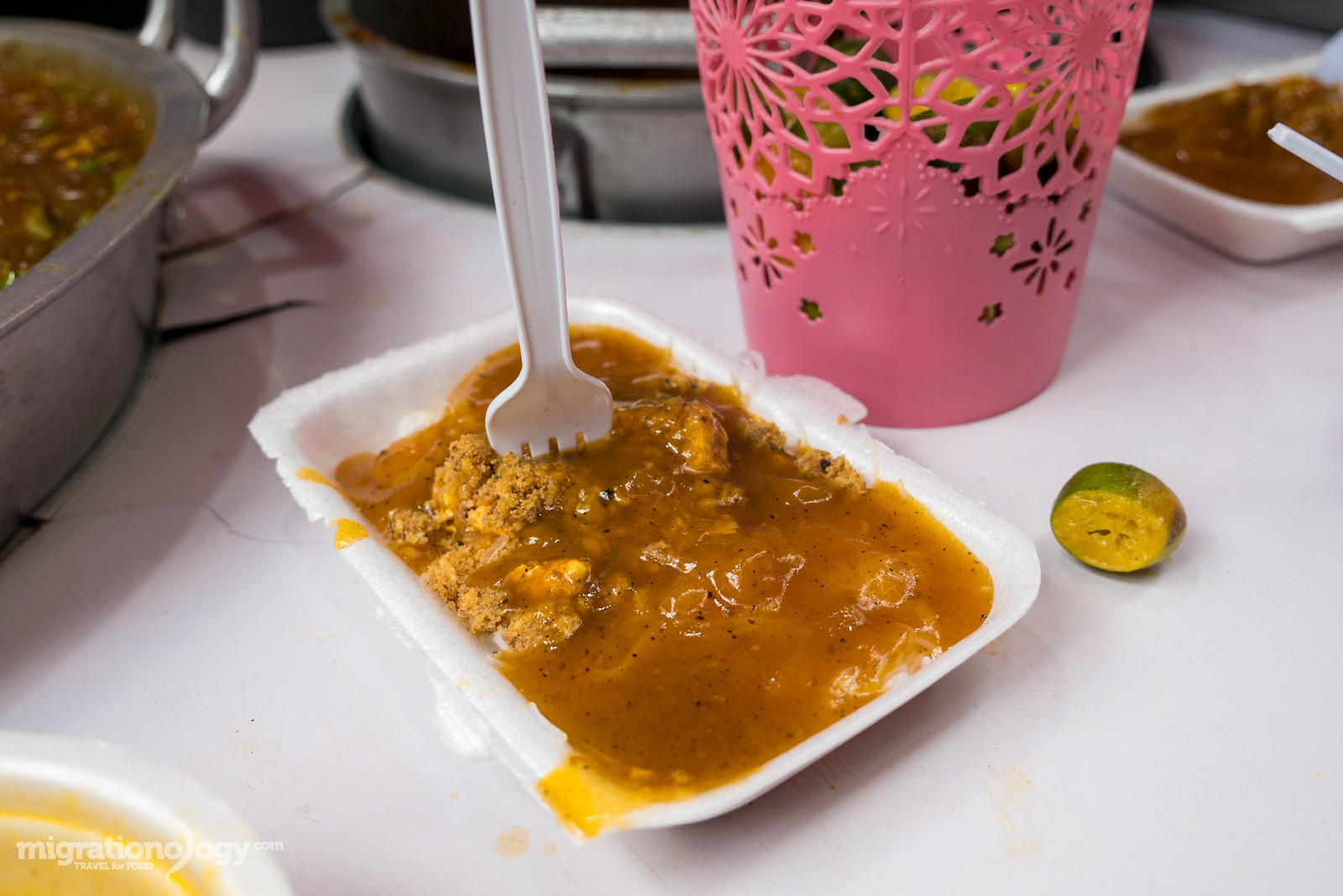 Filipino noodle dish Palabok, a popular street food snack often found in markets like Quiapo Market.
Filipino noodle dish Palabok, a popular street food snack often found in markets like Quiapo Market.
6. Palabok: A Noodle Dish with Rich Flavors
Palabok is a quintessential Filipino noodle dish and a popular street food snack found throughout Manila. It offers a more substantial option compared to skewers and fried snacks.
The base of palabok is thin rice noodles (bihon), generously topped with a thick, flavorful sauce. This sauce is typically made from shrimp broth, ground pork, and crunchy chicharon (fried pork skin), adding a delightful textural contrast. Palabok is often garnished with hard-boiled eggs and sometimes smoked fish flakes (tinapa). The rich, garlicky sauce perfectly complements the delicate rice noodles, creating a comforting and savory snack.
Price: 20 PHP ($0.40)
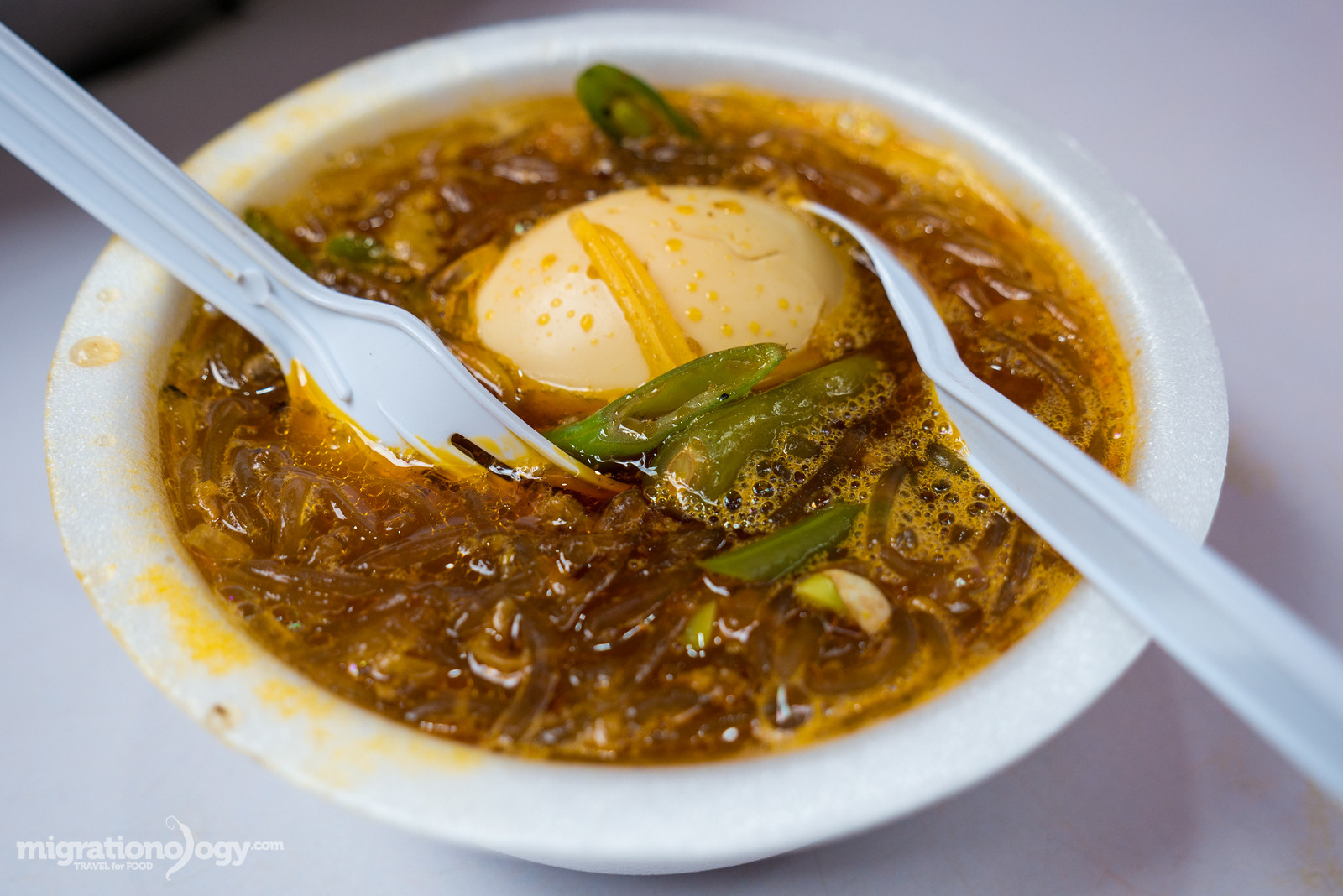 Sotanghon, Filipino cellophane noodles in broth, a comforting street food option.
Sotanghon, Filipino cellophane noodles in broth, a comforting street food option.
7. Sotanghon: Slurpy Cellophane Noodle Soup
Sotanghon, or cellophane noodles, is another popular noodle dish in the Philippines, also readily available as street food. The sotanghon found in Manila’s Quiapo Market features translucent cellophane noodles in a light, oily, and meaty broth, fragrant with the aroma of fried garlic.
This comforting noodle soup often includes hard-boiled egg slices and slivers of long beans or green beans, adding subtle textures and flavors. Sotanghon is the kind of dish you’ll want to slurp until the last drop, perfect for a quick and satisfying meal on the go.
Price: 30 PHP ($0.60)
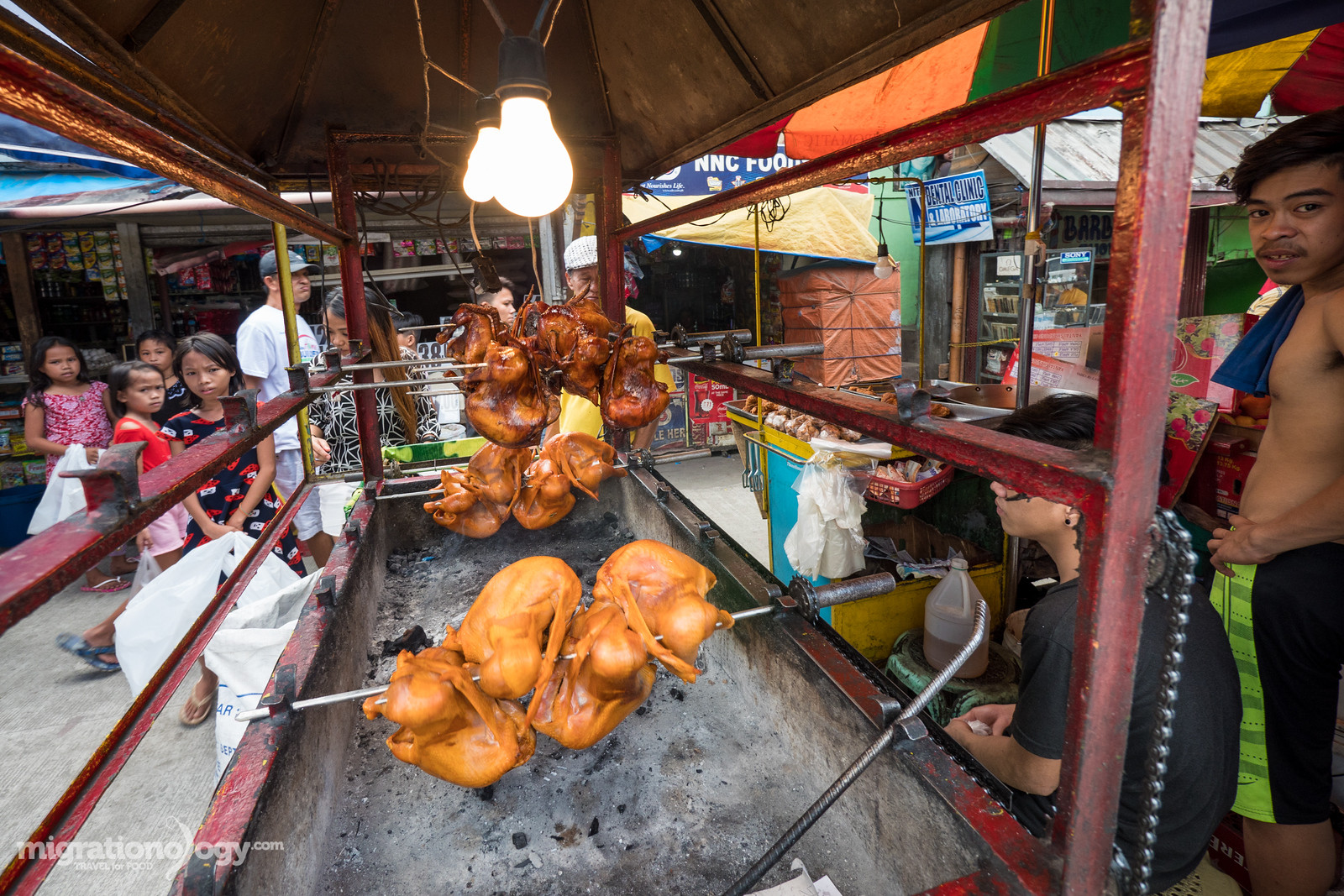 Lechon Manok, Filipino roasted chicken, often sold as street food in Manila.
Lechon Manok, Filipino roasted chicken, often sold as street food in Manila.
8. Lechon Manok: Street-Side Roasted Chicken Perfection
While lechon manok (roasted chicken) is technically a main dish, its prevalence as street food in Manila warrants its inclusion in this snack guide. Street-side rotisserie chicken stalls offer incredibly flavorful and juicy lechon manok that rivals restaurant versions.
The chicken is typically stuffed with lemongrass and marinated in a mixture of soy sauce, sugar, and kalamansi (Filipino lime), before being slow-roasted to golden, crispy perfection. The marinade creates a sweet, savory, and tangy flavor profile that permeates the chicken. Don’t miss the opportunity to try street food lechon manok when in the Philippines.
Price: 85 PHP ($1.71) for a half chicken
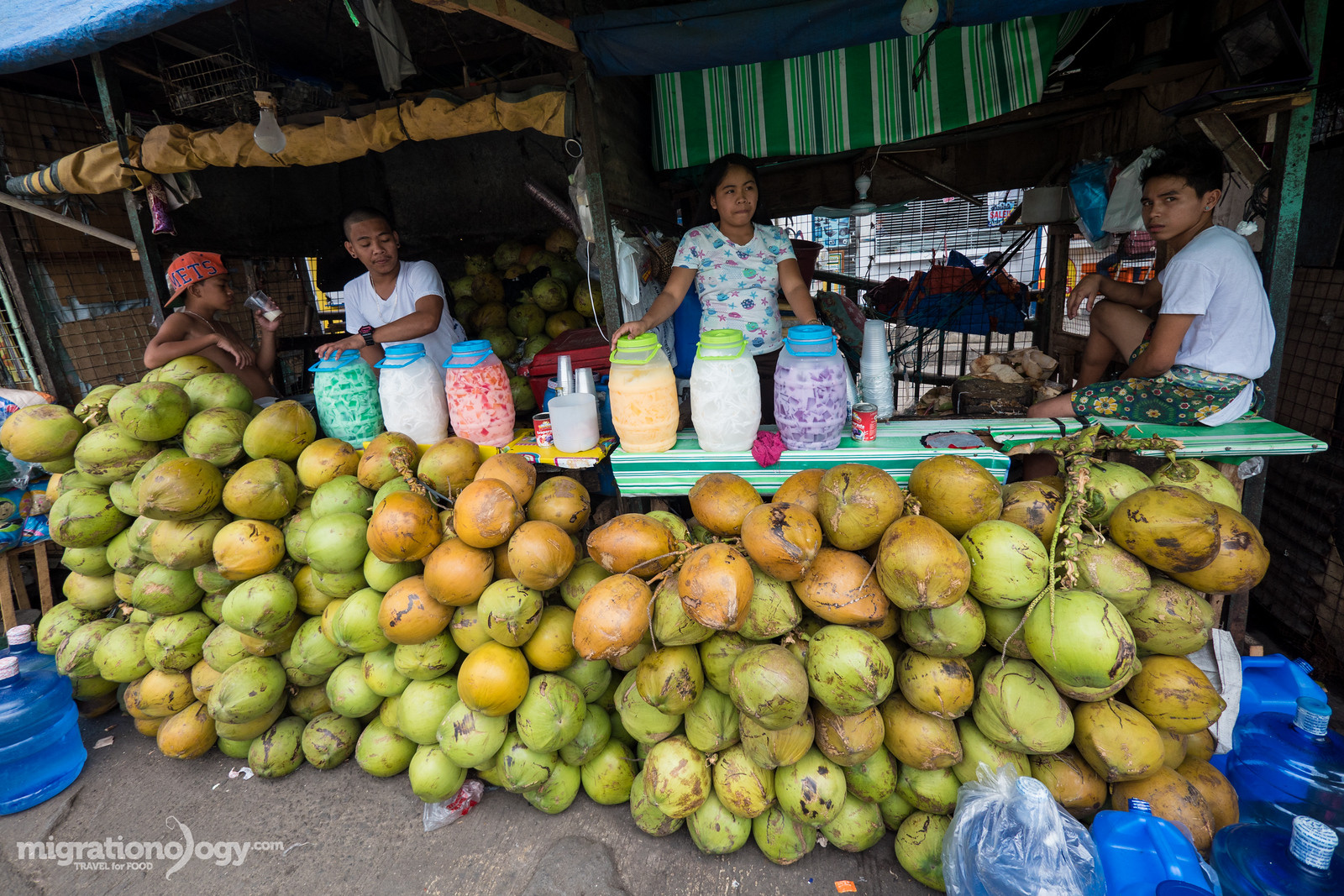 Buko, young coconuts, readily available as a refreshing Filipino street food drink.
Buko, young coconuts, readily available as a refreshing Filipino street food drink.
9. Buko: Nature’s Refreshing Drink
The Philippines, as a tropical archipelago, is naturally abundant in coconuts. Buko refers to young, green coconuts, prized for their refreshing water and tender meat.
While coconuts are used in countless Filipino dishes, enjoying buko in its simplest form is a quintessential experience. At any market or roadside stall, you’ll likely find piles of coconuts ready to be expertly hacked open. The cool, slightly sweet buko juice is incredibly hydrating, and the soft, jelly-like coconut meat is a light and satisfying treat, perfect for combating the tropical heat.
Price: 30 PHP ($0.60)
 Street ice cream cart in the Philippines, offering a sweet and cold Filipino street food treat.
Street ice cream cart in the Philippines, offering a sweet and cold Filipino street food treat.
10. Ice Cream: The “Dirty Ice Cream” Misnomer
Street ice cream in the Philippines, often humorously referred to as “dirty ice cream,” is a beloved sweet snack. Despite the playful nickname, it’s a widely enjoyed treat, particularly on hot days.
Vendors push colorful carts, often ringing a bell to announce their presence. A variety of flavors are available, but surprisingly, cheese ice cream is among the most popular. Don’t be hesitant to try it – it often contains real bits of cheese, adding a unique salty-sweet dimension.
Price: 20 PHP ($0.40)
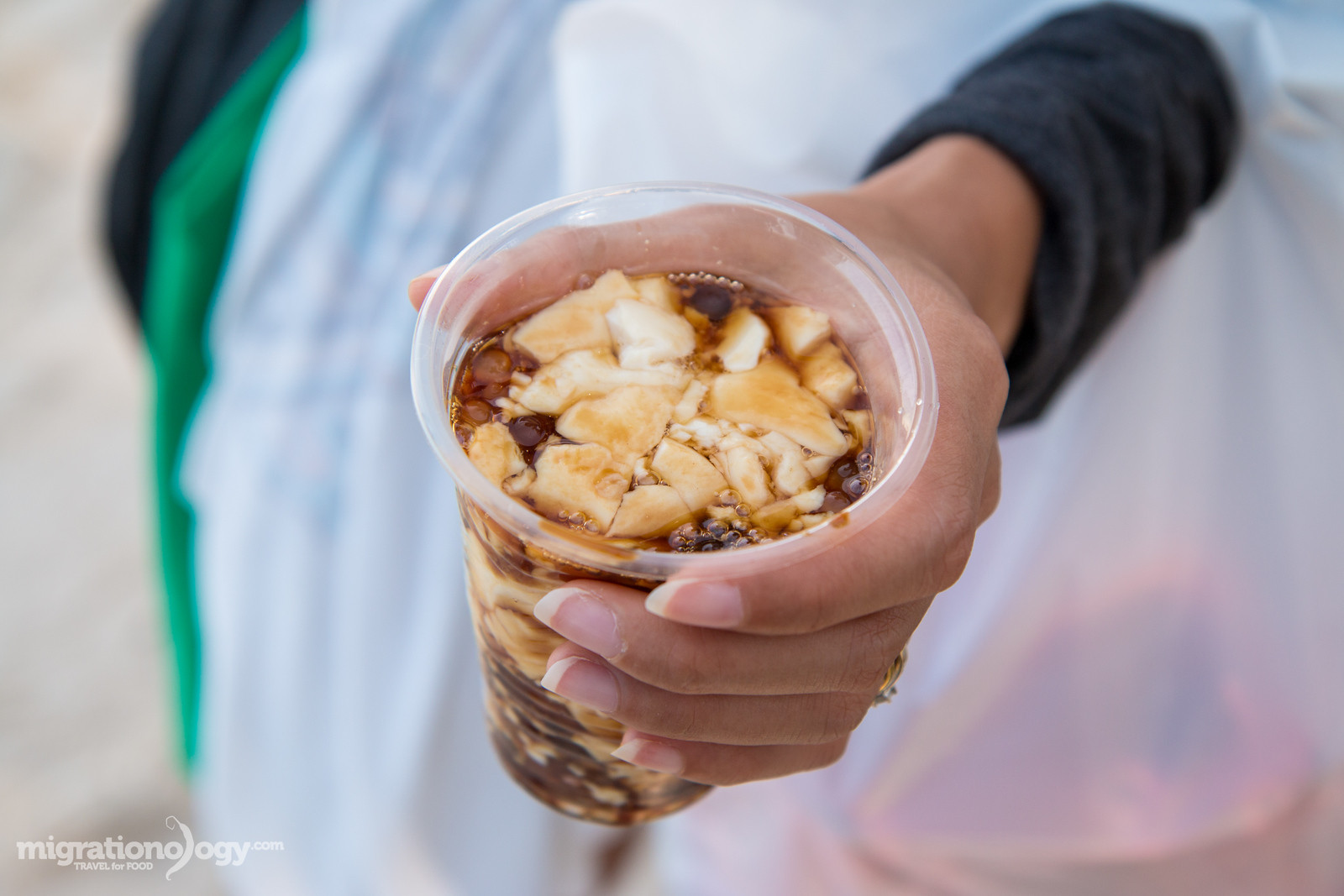 Taho, Filipino soft tofu dessert, a comforting and sweet street food snack.
Taho, Filipino soft tofu dessert, a comforting and sweet street food snack.
11. Taho: Sweet Silken Tofu Delight
Taho is the Filipino adaptation of soft silken tofu (douhua), a dessert with Chinese origins popular throughout Southeast Asia. This comforting snack features incredibly soft tofu, often described as silken, sweetened with a sugary syrup called arnibal and topped with sago pearls (small tapioca balls).
Served warm in a cup, taho can be eaten with a spoon. However, its delicate texture is so soft that it can even be enjoyed by sucking it up with a straw – a fun and unique way to experience this Filipino street food dessert.
12. Halo-Halo: The Mix-Mix Dessert Extravaganza
(Unfortunately, a photo of halo-halo is unavailable.)
Halo-halo, meaning “mix-mix” in Tagalog, is arguably the most iconic Filipino dessert and a refreshing street food favorite. It’s a colorful and chaotic concoction of shaved ice, sweet beans, various fruits, jellies, nata de coco (coconut gel), leche flan, and topped with a scoop of ice cream and a drizzle of evaporated or condensed milk.
Halo-halo is a textural and flavor explosion – sweet, cold, and incredibly satisfying, especially on a scorching afternoon. Each vendor may have their own unique twist, making every halo-halo experience slightly different and always exciting.
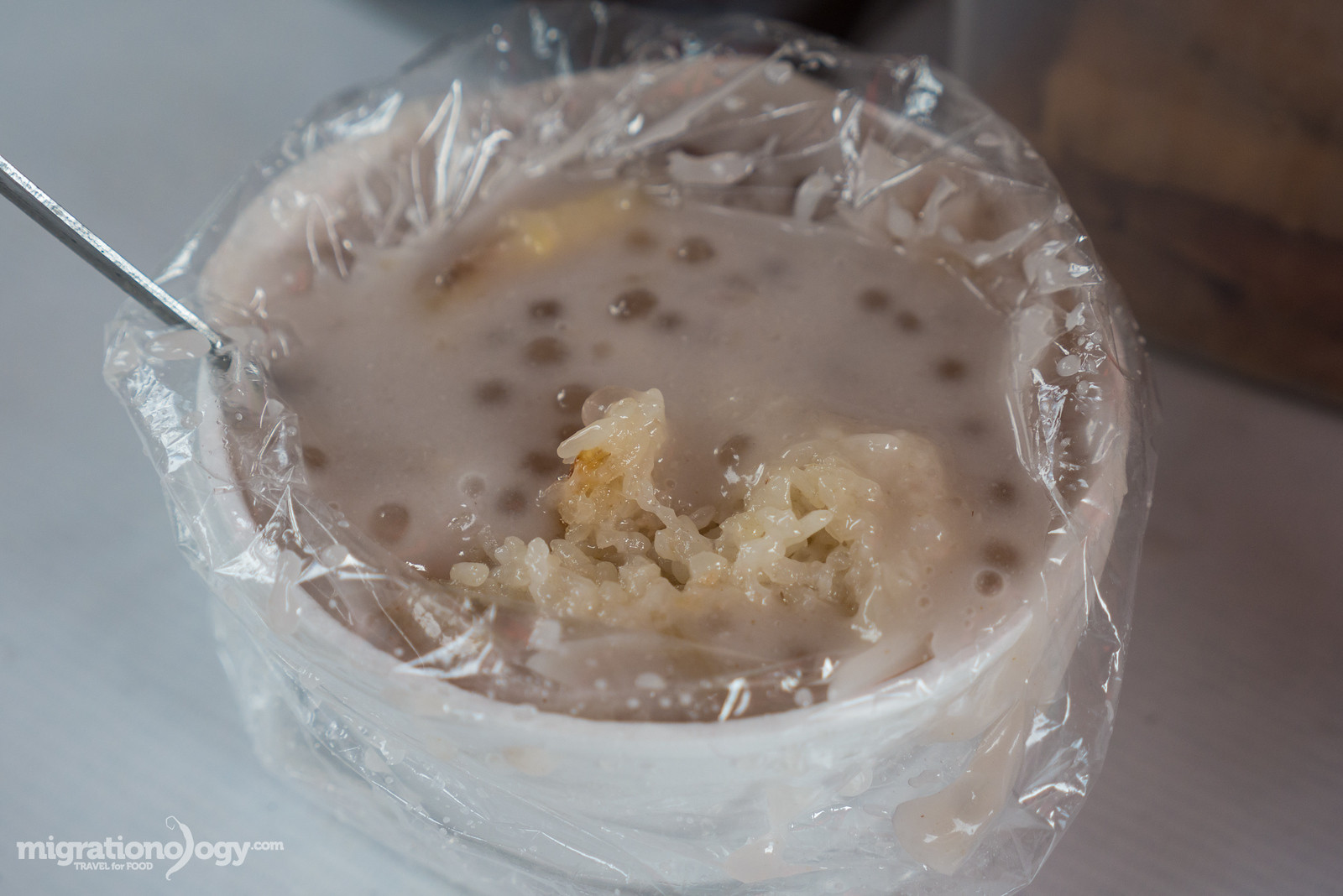 Ginataang Halo-Halo, a warm Filipino dessert with coconut milk, root crops and fruits.
Ginataang Halo-Halo, a warm Filipino dessert with coconut milk, root crops and fruits.
13. Ginataang Halo-Halo: Warm Coconut Milk Dessert Soup
Ginataang halo-halo offers a warm and comforting contrast to the icy halo-halo. This Filipino street food dessert is a rich and creamy soup made with sweetened coconut milk, jackfruit, saba bananas, sweet potatoes, taro, and chewy glutinous rice balls (bilu-bilo) and tapioca pearls.
Served warm, almost like a pudding or thick soup, ginataang halo-halo is a perfect treat for cooler evenings or for those who prefer a less intensely sweet dessert. If you love the flavor of coconut milk and enjoy warm, comforting sweets, this is a must-try.
Price: 20 PHP ($0.40)
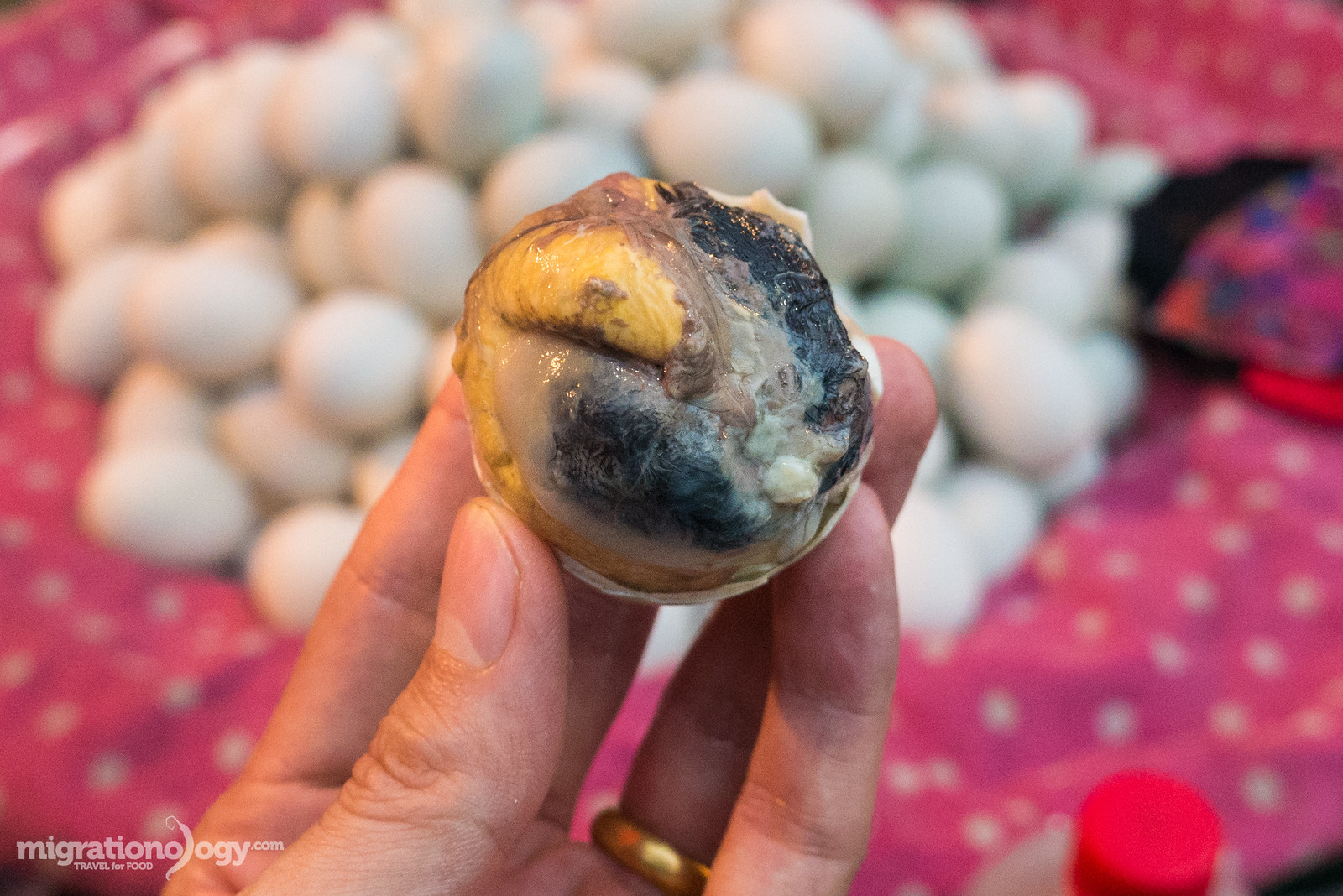 Balut, a developing duck embryo, a famous and unique Filipino street food.
Balut, a developing duck embryo, a famous and unique Filipino street food.
14. Balut: The Infamous Filipino Delicacy
No Filipino street food list is complete without mentioning balut. Perhaps the most famous (and to some, infamous) Filipino street food, balut is a developing duck embryo, boiled and eaten directly from the shell. It’s considered by many to be the “king” of Filipino street food and a true test of adventurous eating.
Balut is widely available and particularly popular as an evening snack, often believed to be an aphrodisiac. To eat balut, you first crack a small opening at the top of the shell and sip the savory broth inside. Then, you peel the shell and season the embryo and yolk with salt and vinegar before consuming the entire egg. Trying balut at a local market is an authentic Filipino culinary experience.
Price: 15 PHP ($.030)
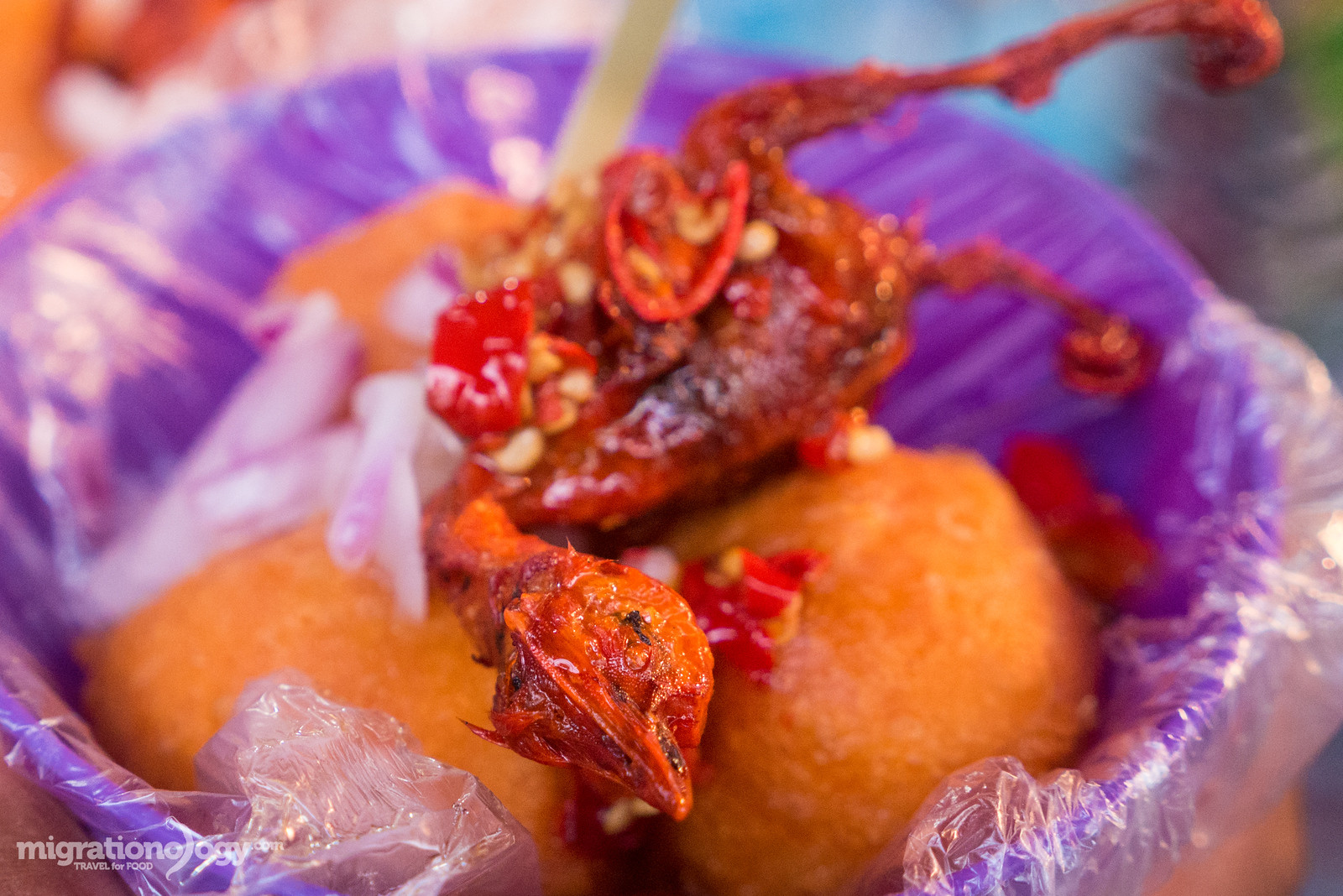 One-day-old fried chicken, a resourceful and unusual Filipino street food snack.
One-day-old fried chicken, a resourceful and unusual Filipino street food snack.
15. One-Day-Old Fried Chicken: Resourceful and Crispy
For another adventurous street food experience, look for one-day-old fried chicken. Commonly found near Quiapo Market and Quiapo Church in Manila, this snack might sound unusual, but it’s a testament to Filipino resourcefulness.
Reportedly, these are often male chicks or rejects from chicken farms. Instead of being discarded, they are deep-fried to a crispy golden brown and seasoned. While it might challenge some palates, it’s a unique and surprisingly crispy snack, minimizing food waste.
Price: 10 PHP ($0.20)
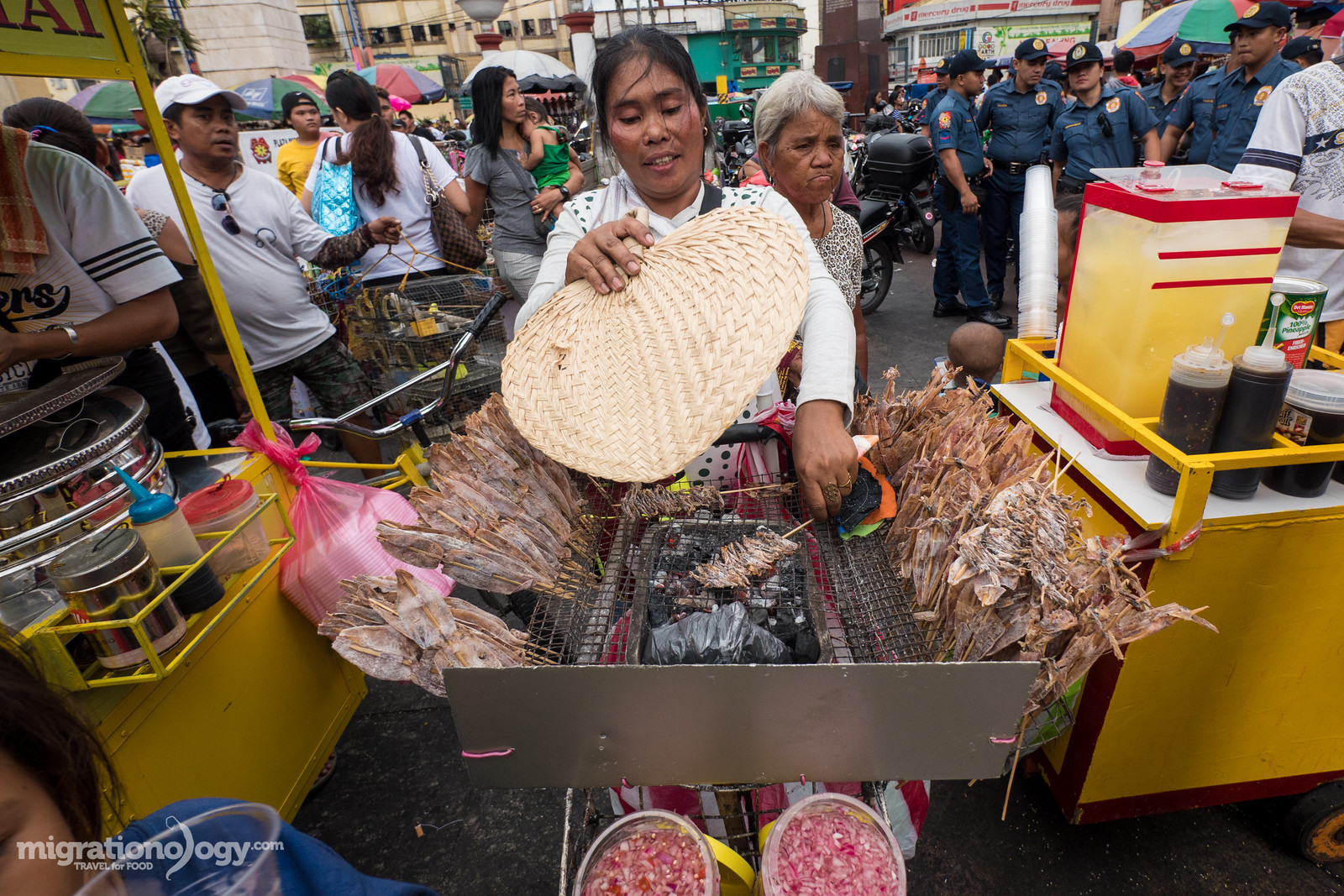 Dried squid skewers, a chewy and flavorful Filipino street food snack.
Dried squid skewers, a chewy and flavorful Filipino street food snack.
16. Dried Squid: Chewy Seafood Snack
Being an archipelago, the Philippines boasts abundant seafood. Dried squid is a popular street food snack that showcases this bounty. Squid is dried in the sun, flattened, and then grilled, resulting in a wonderfully chewy and intensely flavorful snack.
Like many Filipino skewered street foods, dried squid is typically dipped in chili vinegar, allowing you to customize the flavor with vinegar, chilies, and onions. It’s a personal favorite for its satisfying chewiness and savory, slightly smoky taste.
Price: 10 PHP ($0.20) per stick
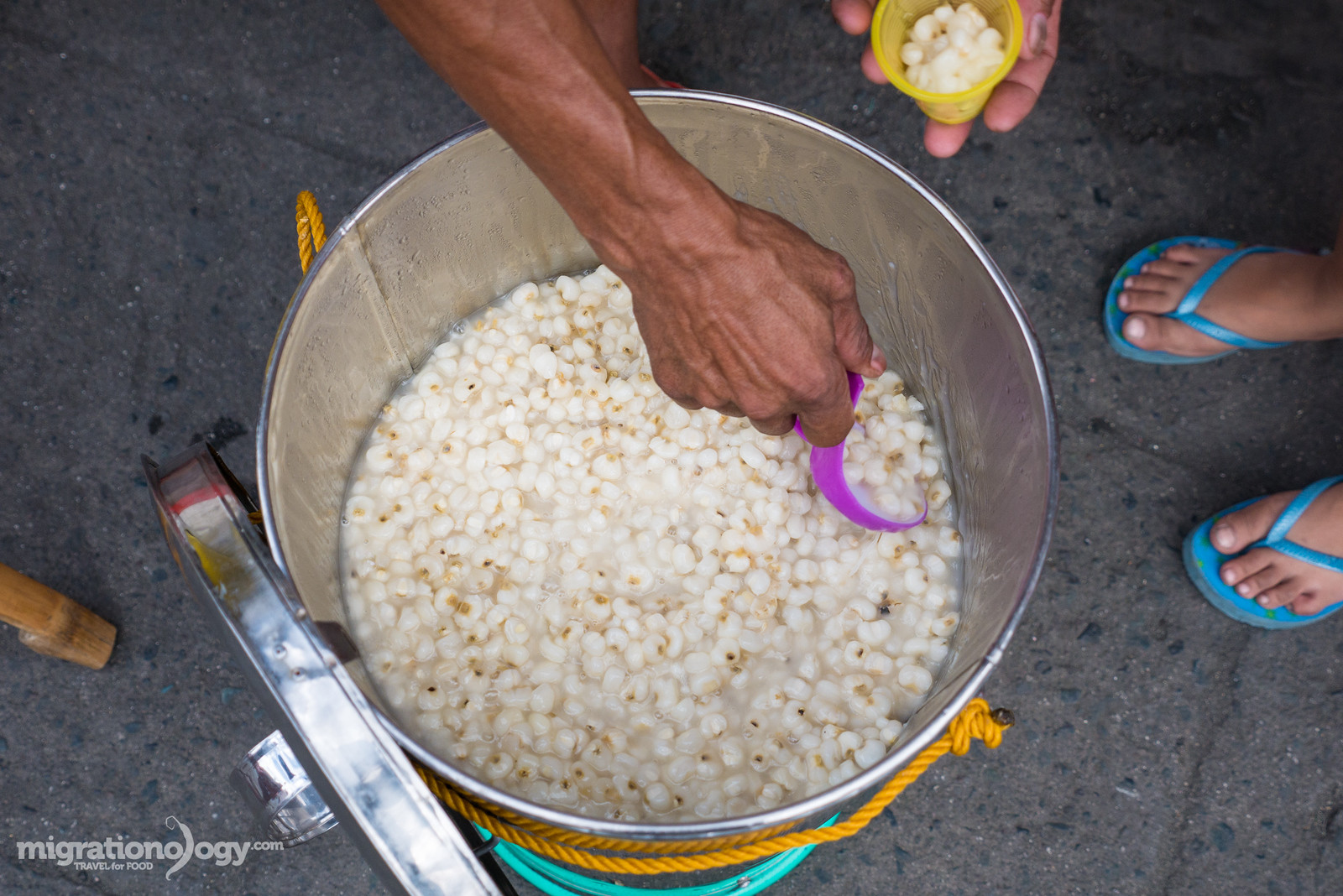 Binatog, boiled corn with coconut, a simple and satisfying Filipino street food snack.
Binatog, boiled corn with coconut, a simple and satisfying Filipino street food snack.
17. Binatog: Simple Corn and Coconut Goodness
Binatog is a remarkably simple yet delicious Filipino street food snack. It consists of corn kernels, often cut fresh from the cob and boiled, sometimes with fragrant lemongrass infused during cooking.
When you order binatog, the vendor scoops the cooked corn into a cup, generously tops it with freshly shredded coconut, and seasons it with salt. While sweet versions with sugar or condensed milk exist, the salty binatog is particularly enjoyable. It’s a starchy, slightly chewy, and subtly sweet snack that highlights the natural flavors of corn and coconut.
Price: 10 PHP ($0.20)
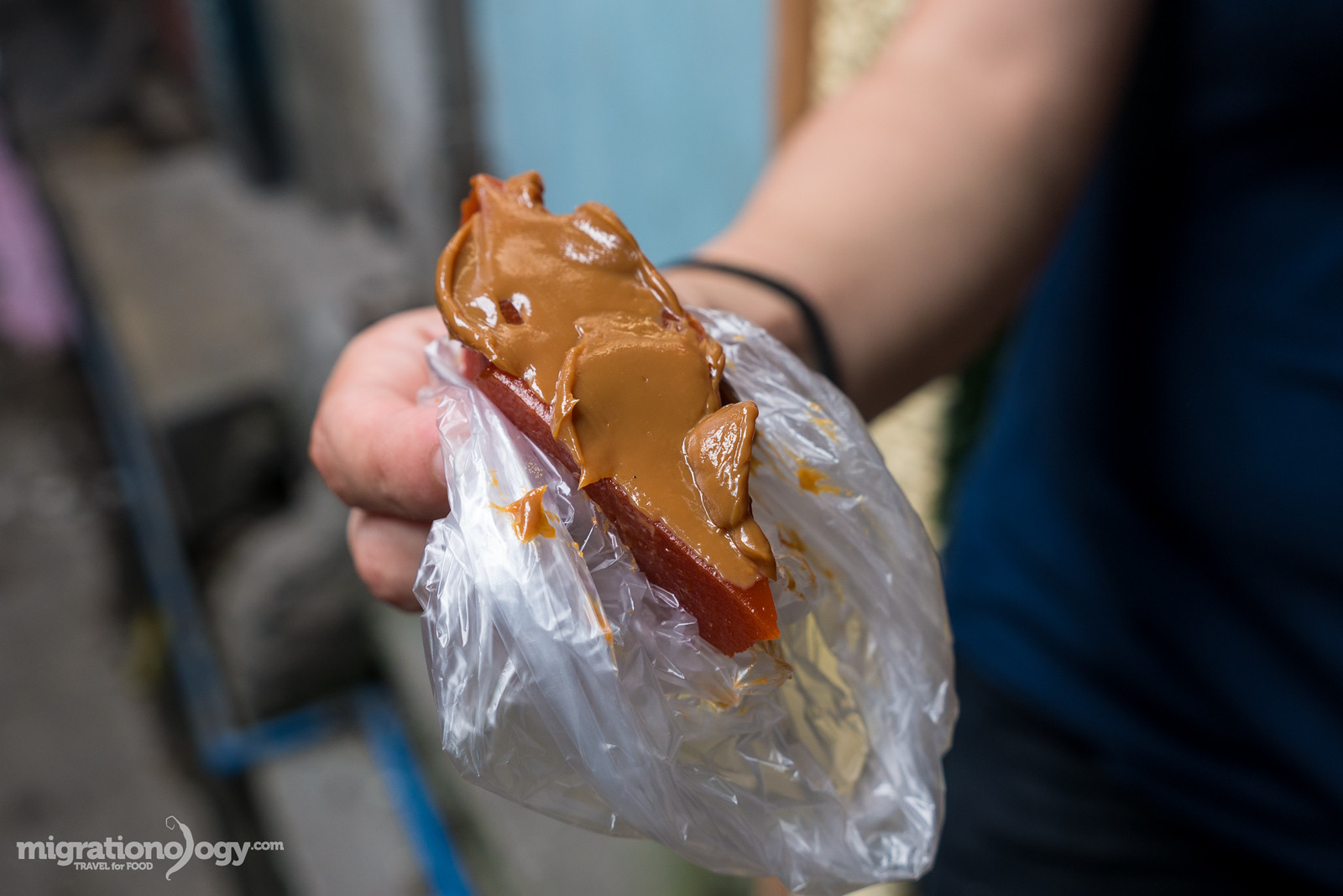 Kutsinta, Filipino steamed rice cake, a sweet and chewy street food dessert.
Kutsinta, Filipino steamed rice cake, a sweet and chewy street food dessert.
18. Kutsinta: Chewy Rice Cake Treat
Kutsinta is a steamed rice cake with a unique, slightly chewy, and jelly-like texture, similar to mochi. It’s a popular Filipino street food dessert, often sold by vendors carrying trays of these brown-orange cakes.
While sometimes served simply topped with grated coconut, kutsinta can also be found drizzled with a type of Filipino dulce de leche – sweetened condensed milk reduced to a sticky caramel. This caramel topping adds a rich sweetness that complements the subtle flavor of the rice cake.
Price: 5 PHP ($0.10)
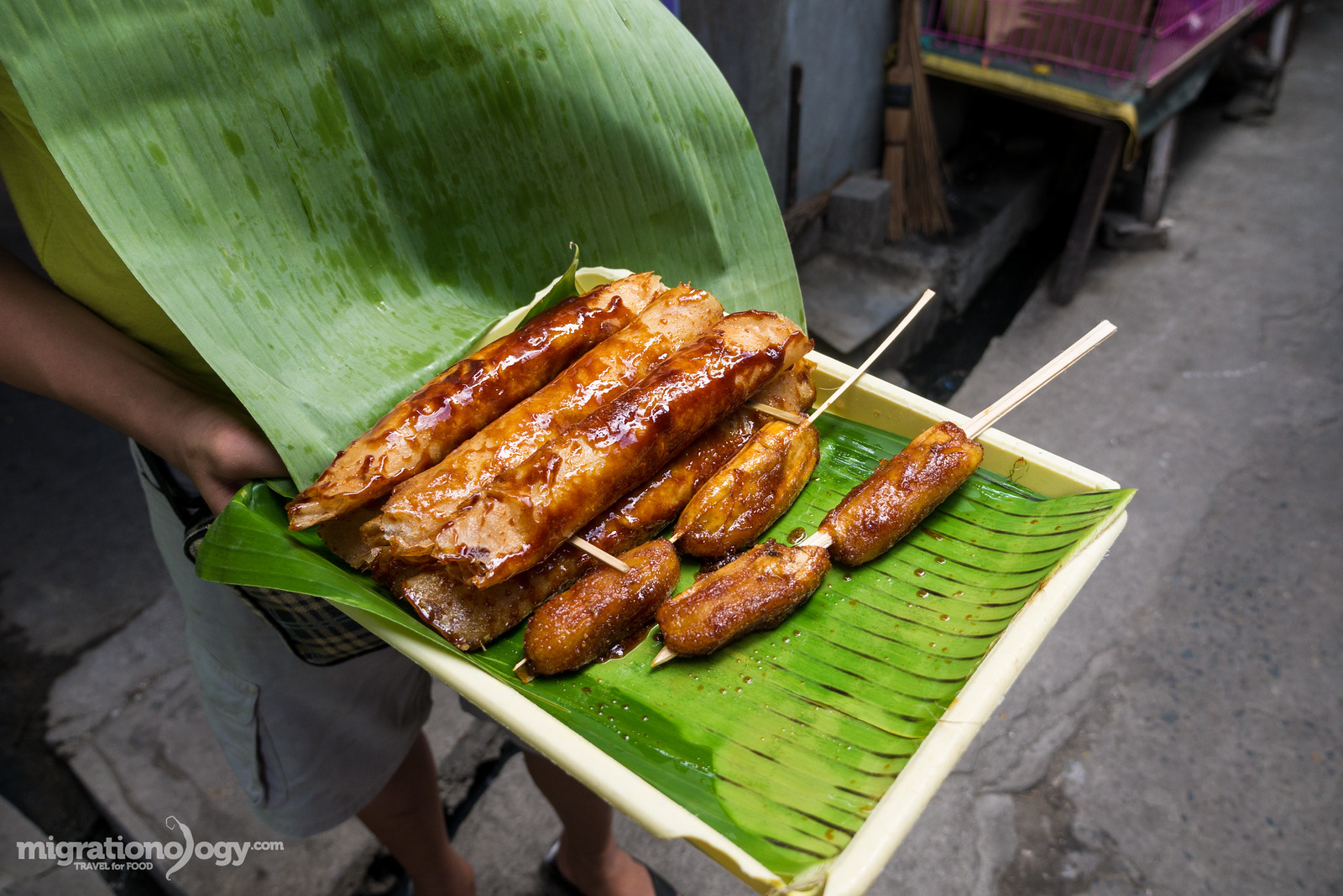 Banana Q, caramelized banana skewers, a sweet and popular Filipino street food snack.
Banana Q, caramelized banana skewers, a sweet and popular Filipino street food snack.
19. Banana Q: Sweet Caramelized Banana Skewers
Often sold alongside turon, banana q (banana cue) is a ubiquitous Filipino street food sweet. It’s incredibly simple yet satisfying: whole bananas skewered and coated in brown sugar, then deep-fried or pan-fried until the sugar caramelizes into a crisp, golden shell.
Banana q is undeniably sweet, but the slightly burnt sugar crust adds a complex caramelized flavor that elevates the simple banana. It’s a quick, easy, and delicious sweet fix.
Price: 12 PHP ($0.24) for a stick
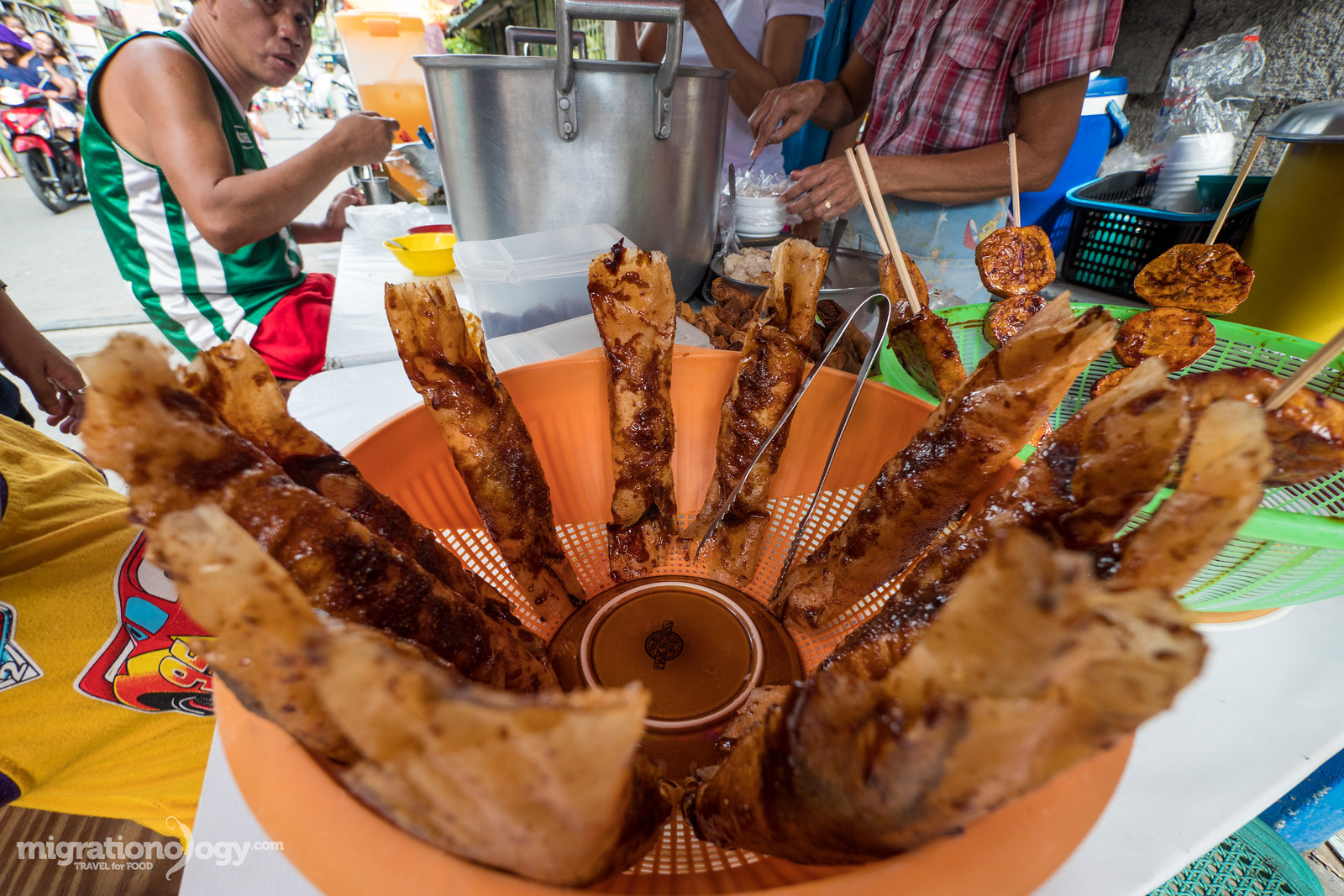 Turon, Filipino banana spring rolls, a crispy and sweet street food dessert.
Turon, Filipino banana spring rolls, a crispy and sweet street food dessert.
20. Turon: Crispy Banana Spring Roll Delight
Turon is a personal favorite among Filipino sweet street food snacks. It’s essentially a banana spring roll, made by wrapping a slice of saba banana (a type of plantain) and a sliver of jackfruit in a thin lumpia wrapper (spring roll wrapper) and deep-frying it until golden and crispy.
The result is a delightful combination of textures and flavors: the soft, sweet-and-sour banana and jackfruit filling contrasts beautifully with the crispy, crunchy outer wrapper. It’s often compared to a banana egg roll but with a distinctly Filipino twist.
Price: 10 PHP ($0.20)
 Filipino street food meal spread, showcasing rice and various dishes, a hearty street food option.
Filipino street food meal spread, showcasing rice and various dishes, a hearty street food option.
21. Rice and Dishes: Hearty Street Food Meals
While this guide primarily focuses on snacks, it’s impossible to ignore the abundance of full Filipino meals available as street food. Venture down side streets and into local neighborhoods, and you’ll discover small, family-run canteens offering a wide array of regional Filipino cuisine.
Similar to “point-and-choose” style eateries found in Indonesia and Thailand, these canteens display various dishes in pots, allowing you to select your preferred combinations to accompany rice. Here, you can find excellent renditions of adobo (a national dish), flavorful stews, soups, curries, and stir-fried dishes. Often, seating is available right by the food stalls, offering a unique “chef’s table” street food experience.
Note: In the Philippines, it’s common practice in some street food settings to serve meals on plates lined with plastic bags. While this practice raises environmental concerns due to plastic waste, it ensures a clean eating surface for each customer.
Price: A full meal like the one pictured can cost around 230 PHP ($4.62) or more, depending on the number of dishes.
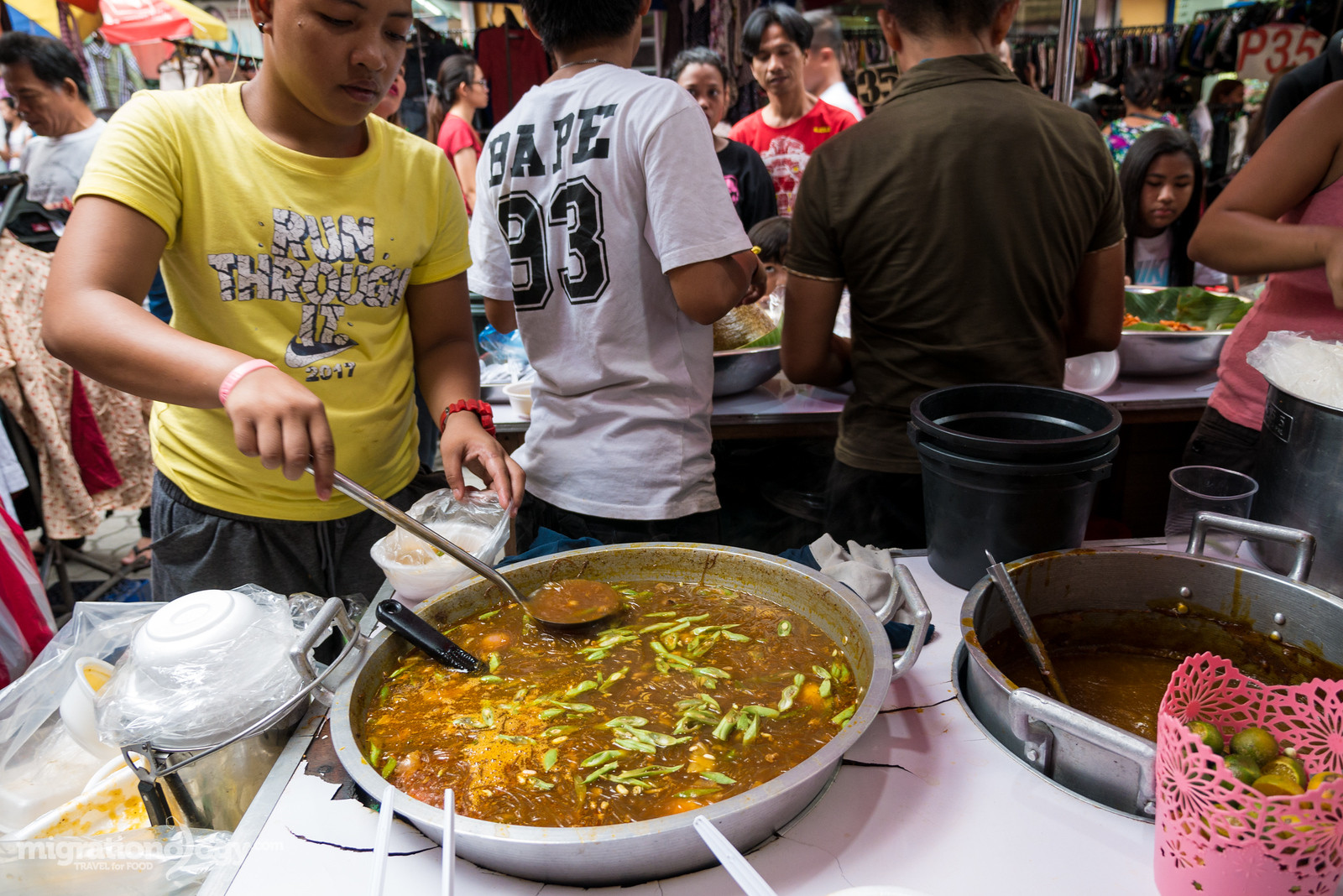 Quiapo Market in Manila, a great place to experience authentic Filipino street food.
Quiapo Market in Manila, a great place to experience authentic Filipino street food.
Where to Find the Best Filipino Street Food
Filipino street food snacks are available virtually everywhere in the Philippines. In Manila, you’ll rarely walk more than a few steps without encountering a street food vendor.
However, it’s wise to exercise some discretion when choosing street food. Opt for stalls that appear clean and have a high turnover of food, indicating freshness. Be more cautious with street foods that involve water or ice in their preparation, especially if hygiene is a concern.
That said, many visitors, including myself, have enjoyed Filipino street food extensively without any issues. The best places to immerse yourself in the street food scene in Manila are local markets and neighborhood streets.
Markets like Quiapo Market and Divisoria Market are excellent starting points, offering a vast and diverse selection of Filipino street food to sample. Exploring local neighborhood streets will also reveal hidden culinary gems and authentic flavors.
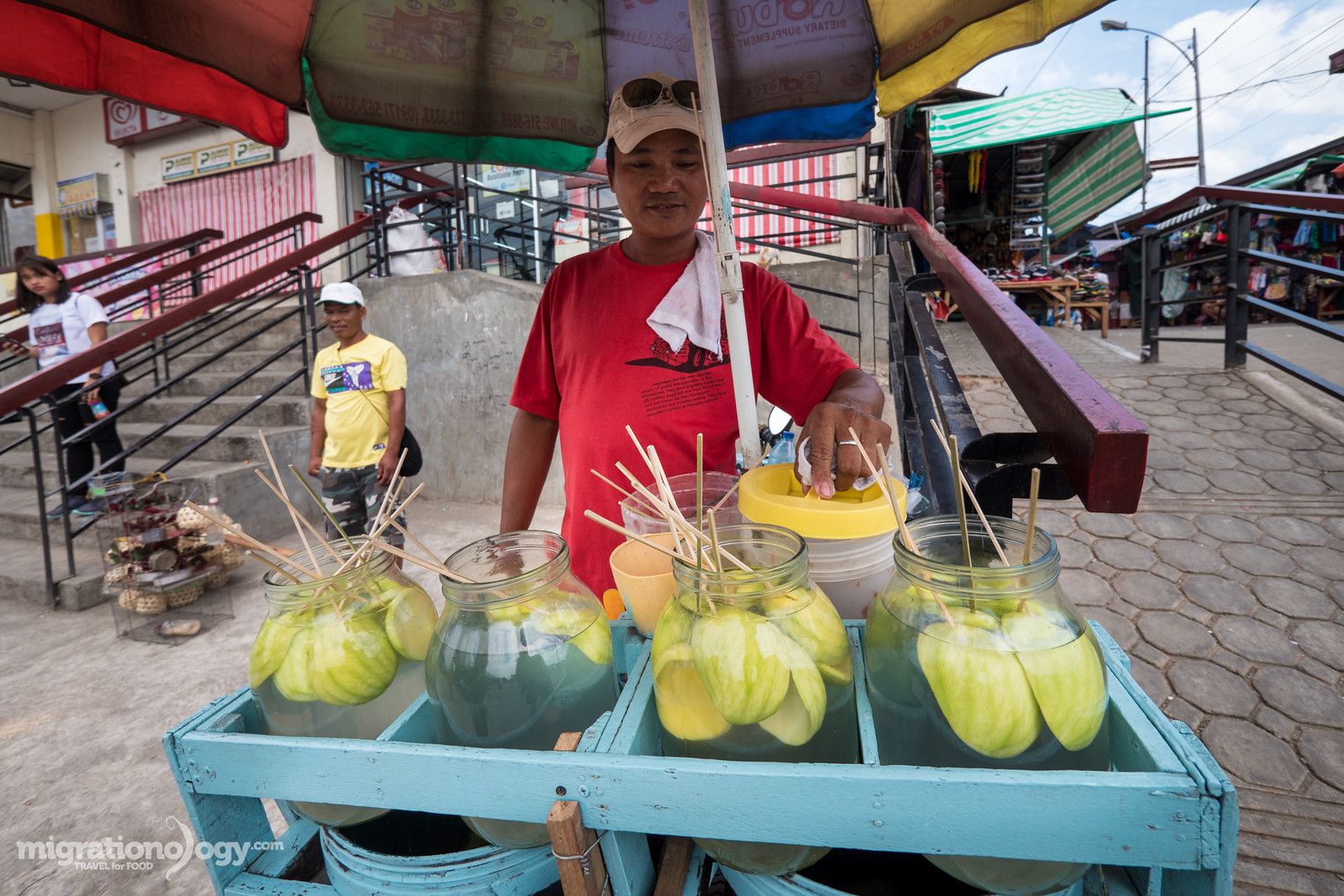 Filipino street food variety, showcasing the diverse and delicious options available.
Filipino street food variety, showcasing the diverse and delicious options available.
Conclusion: A Taste of the Philippines on the Streets
This guide has introduced you to 21 must-try Filipino street food snacks, offering just a glimpse into the incredible variety available. From smoky grilled isaw to adventurous balut and sweet turon, Filipino street food is a culinary adventure waiting to be explored.
Beyond the delicious food, one of the most rewarding aspects of eating street food in the Philippines is the warm hospitality and friendly interactions you’ll have with the people you meet along the way. So, venture out, be adventurous, and enjoy the incredible flavors of Filipino street food!


